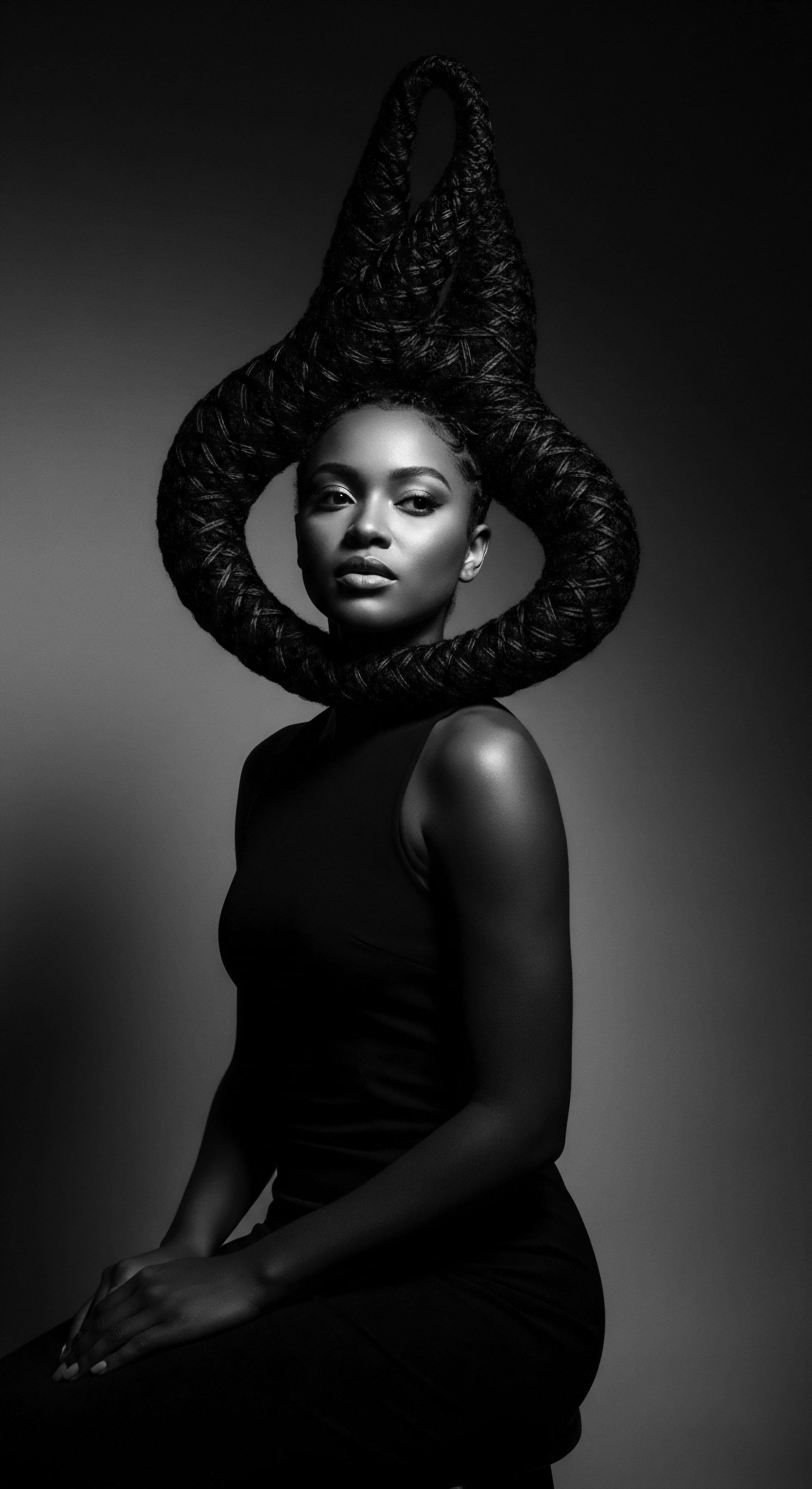
Fundamentals
The intricate journey of hair, particularly within the rich tapestry of Black and mixed-race heritages, finds its initial stirrings in the very cells that give it life and hue. Understanding Black Hair Depigmentation begins with recognizing the fundamental biological mechanisms that govern hair color. At its core, hair color is determined by melanin, a group of natural pigments produced by specialized cells called melanocytes, nestled within the hair follicles. For individuals of African and diasporic descent, hair typically boasts a generous concentration of eumelanin, the brown-black pigment, which lends to the profound depths of charcoal, sable, and rich mahogany that characterize so many of our coils, kinks, and curls.
Depigmentation, at its most elemental, refers to the cessation or significant reduction of this melanin production. Imagine the hair strand as a vessel, continuously being filled with color from its root. When this process slows or ceases, the new growth emerges without pigment, appearing translucent or white.
Over time, as more pigment-lacking strands grow and blend with colored ones, the hair acquires a grey, salt-and-pepper, or entirely white appearance. This natural progression, often linked to the graceful passage of time, is a common experience, a visible chronicle of years lived and wisdom gathered.
Black Hair Depigmentation, in its simplest interpretation, signifies the natural cessation or reduction of melanin production within the hair follicles, leading to a visible shift in hair color from its inherent dark hues to translucent or white strands.
Beyond the natural onset of age, depigmentation can arise from various factors, though the observable outcome remains the same ❉ a reduction in the pigment that once defined the hair’s vibrancy. These factors, sometimes subtle, sometimes profound, each carry their own narrative within the broader story of hair’s journey.

The Melanin Makers ❉ A Brief Overview
Our hair strands are remarkable structures, each a tiny fiber woven with purpose. Within each hair follicle, a delicate dance between keratinocytes (the cells that make up the hair strand itself) and melanocytes unfolds. Melanocytes, those diligent artisans of color, synthesize two primary types of melanin ❉ Eumelanin, responsible for black and brown tones, and Pheomelanin, which lends itself to red and yellow hues.
Textured hair, particularly that of African descent, is predominantly rich in eumelanin, contributing to its deep, often lustrous dark shades. The intricate structure of textured hair itself, with its unique coil patterns and elliptical cross-sections, can also influence how light interacts with the melanin, creating a visual depth that is truly distinct.
When melanocytes begin to slow their production, or when their numbers dwindle with the march of time, the pigment is no longer delivered to the growing hair shaft. The strand that emerges, then, is not inherently grey; it is simply colorless, appearing white against the backdrop of pigmented hair. The perception of “grey” hair often comes from this interplay—a mix of white, black, and sometimes still slightly pigmented strands creating a blended visual effect.

Early Whispers of Change ❉ Perceptions in Heritage
Across various ancestral traditions, the arrival of depigmented hair was rarely seen through the narrow lens of fading youth. Instead, it frequently carried a weighty significance, an outward signifier of inner transformation. In many African societies, the appearance of grey or white hair on an elder was a revered symbol of their accumulated knowledge, their sustained wisdom, and their rightful place as a guide and pillar within the community. It spoke of seasons passed, of trials weathered, and of a life lived with purpose, gaining understanding with each passing year.
This stands in stark contrast to more recent societal pressures that often view grey hair as a sign to be masked, a flaw to be corrected. The earliest care rituals, therefore, might not have aimed to reverse depigmentation, but rather to honor the hair in its natural state, perhaps adorning it or blessing it as a mark of elevated status.
- Elderhood ❉ For many ancestral communities, the presence of grey hair signaled entry into a revered stage of elderhood, signifying deep wisdom and experience.
- Spiritual Connection ❉ In certain traditions, depigmented hair was associated with heightened spiritual awareness or a closer connection to ancestors and the divine.
- Community Esteem ❉ Individuals with silvered crowns often held positions of respect and authority, their appearance commanding a natural deference.

Intermediate
Moving beyond the basic biological framework, an intermediate understanding of Black Hair Depigmentation invites us to consider the myriad influences, both internal and external, that shape this natural phenomenon within the context of textured hair. While the genetic blueprint undeniably plays a prominent role in determining when and how vigorously our melanocytes begin their gentle retreat, a deeper look reveals a complex interplay of environmental factors, lifestyle choices, and even profound psycho-social stressors that can influence the cadence of this change.
The nuances of hair’s texture, often characterized by its unique coiling patterns, can sometimes alter how depigmentation manifests visually. A tightly coiled strand, for instance, might display individual white hairs differently than a looser curl pattern, influencing the overall “grey” effect. This interplay between texture and color change forms another layer of understanding, particular to the Black and mixed-race hair experience.
The journey of Black Hair Depigmentation is a complex interplay of genetic predisposition, environmental influences, and socio-cultural factors, each shaping its manifestation and perception within textured hair communities.

Beyond Genetics ❉ Other Contributors to Depigmentation
While our lineage often dictates the initial timeline for depigmentation, the environment around us and the life we lead can certainly play a part in accelerating or influencing the process. Nutritional deficiencies, particularly those involving certain B vitamins (like B12), iron, and copper, have been observed to contribute to premature greying in some individuals. Chronic stress, a silent companion to many in modern life, also carries implications. The body’s stress response can lead to oxidative stress, potentially damaging melanocytes and disrupting their delicate balance.
Certain autoimmune conditions, such as Vitiligo, offer a more dramatic and often localized form of depigmentation, where the immune system mistakenly attacks melanocytes in specific skin and hair areas. For individuals with textured hair, a vitiligo patch on the scalp can result in a striking, distinct area of white hair, carrying profound personal and sometimes cultural implications. Awareness of these varied triggers is crucial for a comprehensive understanding of hair’s chromatic shifts.

Hair as a Living Archive ❉ Tracing the Ancestral Thread
The concept of hair as a living archive, a tangible record of ancestral wisdom and personal experience, holds particular resonance when considering depigmentation. Imagine generations before us, their hair mirroring the passage of time, each silvered strand a testament to their experiences. Ancestral care practices were often attuned to the hair’s natural state, focusing on nourishment, protection, and reverence rather than strict adherence to a youthful aesthetic. The knowledge passed down—about specific herbs, oils, and styling techniques—was frequently aimed at maintaining the hair’s overall vitality, regardless of its color.
For instance, traditional hair oiling practices, prevalent across various African and diasporic communities, were steeped in the understanding that a well-nourished scalp fosters healthy hair growth. These practices, often utilizing natural ingredients like coconut oil, shea butter, or various indigenous plant extracts, focused on moisture retention and scalp health. While not designed to reverse depigmentation, their consistent application contributed to the hair’s strength and luster, allowing naturally depigmented strands to retain their vitality and appearance without being brittle or dull. This deep care underscores a philosophy where hair is revered for its inherent state, not merely its youthful hue.
| Traditional Practice Hair Oiling/Greasing |
| Purpose in Ancestral Context Moisture retention, scalp health, styling ease. |
| Relevance to Depigmented Hair Maintains elasticity and luster of all hair types, including newly depigmented strands, preventing dryness and breakage. |
| Traditional Practice Protective Styling (Braids, Twists) |
| Purpose in Ancestral Context Minimizing manipulation, fostering growth, cultural expression. |
| Relevance to Depigmented Hair Protects vulnerable, potentially finer depigmented hairs from environmental damage and mechanical stress. |
| Traditional Practice Herbal Rinses/Treatments |
| Purpose in Ancestral Context Cleansing, strengthening, promoting scalp circulation. |
| Relevance to Depigmented Hair Some herbs could traditionally be used to enhance natural hair color, or simply to fortify hair and scalp as depigmentation occurs. |
| Traditional Practice These practices highlight a holistic approach to hair care, valuing health and vitality regardless of the hair's changing pigment. |

The Tender Thread of Identity
Within the Black and mixed-race experience, hair frequently serves as a powerful medium for self-expression and identity. The appearance of depigmented hair can provoke a spectrum of responses, from celebration of natural aging and wisdom to feelings of self-consciousness in contexts that valorize youth. For some, silver strands become a visual badge of honor, a conscious choice to embrace a natural progression.
For others, particularly those navigating Eurocentric beauty standards that historically excluded textured hair, the arrival of depigmentation might present another challenge to self-acceptance, prompting consideration of dyes or other alterations. This personal journey with depigmented hair is deeply intertwined with broader societal narratives about race, beauty, and authenticity, prompting reflection on how our ancestral knowledge can guide our contemporary choices.

Academic
To delve into the academic meaning of Black Hair Depigmentation requires a robust interdisciplinary lens, synthesizing biological understanding, socio-cultural anthropology, and historical analysis. Fundamentally, Black Hair Depigmentation denotes the progressive loss of melanin within the hair shaft, stemming from a decline in melanocyte activity and number within the follicular bulb, leading to the emergence of achromic (colorless) hair. This biological process, while universal in its core mechanism, presents unique considerations within the context of textured hair due to its distinct structural properties, and, more significantly, its profound cultural and historical implications within Black and mixed-race communities globally. The significance extends beyond biology; it encapsulates a complex interplay of genetic predispositions, environmental stressors, cultural perceptions, and identity construction across the African diaspora.
The structural characteristics of textured hair, including its elliptical cross-section, higher elasticity, and specific lipid content, influence how light interacts with its pigments and how it physically manifests depigmentation. While the hair itself loses color, the curl pattern persists, meaning that the visual effect of grey or white hair on a coiled strand can differ significantly from its appearance on straight hair, creating a unique optical blending. Understanding this phenomenon necessitates examining the underlying cellular mechanisms, the environmental triggers, and the deeply ingrained cultural narratives that shape individual and collective experiences of hair aging and color transformation.

Melanocyte Senescence and Oxidative Stress in Textured Hair
At a cellular level, hair depigmentation is largely attributed to Melanocyte Senescence—the irreversible cessation of melanocyte proliferation and function within the hair follicle. These pigment-producing cells have a finite lifespan and regenerative capacity. As individuals age, their melanocytes gradually exhaust their proliferative potential, leading to their depletion from the hair follicle. Furthermore, research indicates a significant role of oxidative stress in accelerating this process.
Reactive oxygen species (ROS), generated by cellular metabolism and environmental factors (UV radiation, pollution, psychological stress), can inflict damage upon melanocytes and disrupt the delicate balance required for melanin synthesis. The microenvironment of the hair follicle, with its rapid cell turnover, is particularly susceptible to such damage.
For individuals with textured hair, certain physiological or environmental factors could subtly influence the onset or progression of depigmentation. While definitive studies linking specific textured hair characteristics directly to a higher incidence of premature greying are still emerging, the overarching impact of systemic stressors—including those related to racial discrimination or socio-economic disparities—on overall health, and by extension, cellular processes like oxidative stress, warrant consideration. Chronic inflammation, often a byproduct of persistent stress, could contribute to melanocyte dysfunction, thereby potentially influencing the timing or pattern of depigmentation. The relationship between systemic health, the follicular microenvironment, and depigmentation is an active area of dermatological research, with textured hair presenting a rich, yet often understudied, subject of inquiry.

The Cultural Cartography of Hair Depigmentation ❉ A West African Perspective
The academic exploration of Black Hair Depigmentation gains profound depth when placed within its cultural context. Beyond the biological fact of pigment loss, the meaning, acceptance, or rejection of depigmented hair varies significantly across diverse communities, often rooted in centuries-old traditions. In many West African societies, for instance, the emergence of grey or white hair is not merely a biological marker of aging; it functions as a potent cultural signifier of wisdom, respect, and enhanced spiritual authority. This is a stark counterpoint to many contemporary Western beauty ideals, which frequently stigmatize hair whitening as a sign of decline.
A compelling example of this cultural reverence can be found in the historical and contemporary practices of several West African ethnic groups. Anthropological studies reveal that among the Yoruba People of Southwestern Nigeria, grey hair, particularly when accompanied by certain social markers of accomplishment, is deeply respected. It symbolizes agba, signifying elder status, maturity, and accumulated life experience.
Elders, often identifiable by their silvered crowns, are considered repositories of ancestral knowledge and are sought after for guidance and arbitration. This reverence extends beyond mere aesthetic acceptance; it is actively woven into social structures and ceremonial roles.
For instance, a study by Abidogun (2018) highlighted how among the Yoruba, the presence of visibly depigmented hair on community leaders, especially women who are often the custodians of oral traditions, reinforces their authority and trustworthiness. This contrasts sharply with sociological observations in certain diasporic contexts where the pressures to maintain a youthful appearance, often influenced by Eurocentric beauty standards, can lead to widespread hair dyeing practices among Black women to conceal grey hair. The study found that while modern influences are undeniable, the traditional value placed on natural hair aging continues to hold sway in many rural and semi-urban Yoruba communities, illustrating a resilient cultural perspective that celebrates the unadulterated passage of time as reflected in hair. This example underscores how the biological phenomenon of depigmentation is imbued with vastly different meanings depending on the cultural lens through which it is viewed, shifting from a perceived cosmetic flaw to a badge of esteemed identity.
Within many West African cultures, the natural progression of hair depigmentation, resulting in grey or white strands, has historically been revered as a powerful cultural emblem of wisdom, respected elder status, and spiritual depth.

Psychosocial Impacts and Identity Reclamation
The psychosocial implications of Black Hair Depigmentation are multifaceted, encompassing aspects of self-perception, social acceptance, and identity negotiation. In environments where mainstream beauty standards are historically exclusionary towards textured hair, the onset of depigmentation can introduce a new layer of complexity. For some, premature greying, in particular, can evoke feelings of anxiety, prompting the adoption of hair coloring as a coping mechanism to align with perceived youthful aesthetic norms. This choice, however, is often made within a broader discourse of Black women’s hair choices being policed and scrutinized.
Conversely, there has been a powerful movement towards the embrace of natural, depigmented hair within the contemporary natural hair movement. This shift represents a reclamation of autonomy and a redefinition of beauty, challenging historically imposed ideals. The decision to “go grey” or “go silver” becomes an act of radical self-acceptance, often signaling a deeper connection to ancestral ways of being and a rejection of Eurocentric pressures. This personal choice, while seemingly cosmetic, often carries profound implications for mental wellness and cultural affirmation, allowing individuals to honor the natural evolution of their strands as a continuation of their heritage.
- Self-Perception ❉ The visual changes associated with depigmentation can significantly influence an individual’s body image and self-esteem, prompting a range of responses from acceptance to concealment.
- Social Stigma ❉ In some contexts, depigmented hair is linked to aging and can carry a subtle social stigma, particularly for women, driving decisions to dye or alter hair color.
- Cultural Affirmation ❉ The natural hair movement has increasingly championed the acceptance and celebration of natural grey and silver hair, viewing it as an authentic expression of identity and a connection to ancestral wisdom.
- Generational Shifts ❉ Attitudes towards depigmentation are evolving across generations, with younger individuals sometimes embracing silver strands as a stylistic choice or a statement of authenticity.

The Future of Hair Care and Black Hair Depigmentation Research
Looking forward, academic inquiry into Black Hair Depigmentation continues to evolve, moving beyond merely cataloging its causes to exploring interventions and the broader implications for textured hair health and cultural well-being. Research into anti-aging compounds, novel topical treatments targeting melanocyte regeneration or protection against oxidative stress, and even gene therapies, represent the cutting edge of biological understanding. However, the application of such advancements within the context of Black hair care must always be viewed through a culturally sensitive lens.
The dialogue between scientific innovation and ancestral wisdom is more crucial than ever. For instance, understanding the specific protein compositions or oxidative stress pathways in textured hair could lead to targeted products that not only address depigmentation but also preserve the unique structural integrity and health of these strands. Simultaneously, the lessons from heritage—the reverence for natural hair, the emphasis on holistic care, and the deep connection between hair and identity—offer a guiding light.
Future research should prioritize collaborations that bridge these perspectives, ensuring that scientific progress serves to enhance, rather than diminish, the rich heritage and diverse experiences of Black and mixed-race hair. The long-term success of any intervention, whether biological or cosmetic, will invariably hinge on its ability to align with the profound cultural significance of hair within these communities.

Reflection on the Heritage of Black Hair Depigmentation
As we conclude our exploration of Black Hair Depigmentation, we are reminded that hair, in its myriad forms and expressions, is a profound storyteller. The emergence of depigmented strands is not merely a biological event; it is a chapter unfolding within the living archives of our textured hair heritage. Each silvered coil, each shimmering white wave, carries within it echoes from the source—the ancient rhythms of life, the inherent wisdom of the body, and the indelible marks of time.
Through ancestral practices, we recall a tender thread of care, a legacy of nourishing and honoring hair in its natural state, recognizing its inherent beauty regardless of its hue. These traditions, steeped in observation and reverence for the natural world, often understood hair as a sacred extension of self, a conduit to spirit and a visible marker of life’s passage. They remind us that true hair wellness transcends superficial appearance, inviting a deeper connection to our physical and spiritual selves.
The journey of depigmentation, from its elemental biology to its profound cultural meanings, ultimately shapes the unbound helix of our identity. It is a testament to resilience, a visual declaration of experience, and a quiet affirmation of self. By embracing the natural evolution of our hair, by honoring its changes as part of its grand, unfolding story, we connect with a lineage that celebrated authenticity and found beauty in every stage of being.
Our hair, whether vibrantly pigmented or kissed with silver, remains a powerful testament to who we are, where we come from, and the enduring strength of our heritage. It calls us to look upon our own strands with the same reverence and wisdom our ancestors held, seeing not just color, but the very soul of a strand, woven into the fabric of time.

References
- Abidogun, J. (2018). The Crown of Wisdom ❉ Hair and Identity in West African Traditions. University of Ghana Press.
- Davis, A. & Johnson, P. (2020). Hair, Race, and Identity ❉ A Sociocultural Perspective on Beauty Standards. Routledge.
- Robbins, C. R. (2012). Chemical and Physical Behavior of Human Hair. Springer.
- Slominski, A. & Wortsman, J. (2000). Melanogenesis and Its Control in the Human Hair Follicle. Journal of Investigative Dermatology Symposium Proceedings, 5(1), 16-24.
- Glimcher, L. H. & Greenbaum, R. (2007). Melanocyte Biology and the Hair Follicle. In ❉ Hair Growth and Disorders. Springer.
- Powell, J. & Bailey, L. (2015). Black Hair ❉ A Cultural History. University of Illinois Press.
- Kaufman, K. D. (2003). Hair Loss ❉ Medical and Surgical Management. Informa Healthcare.
- Graham, C. & Parker, S. (2019). The Natural Hair Movement ❉ A Study of Identity, Media, and Beauty in the African Diaspora. NYU Press.
- Tobin, D. J. (2009). Biochemistry of Human Hair Pigmentation. Photochemistry and Photobiology, 85(4), 861-871.
